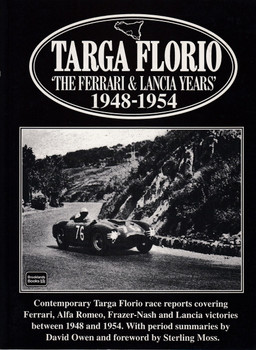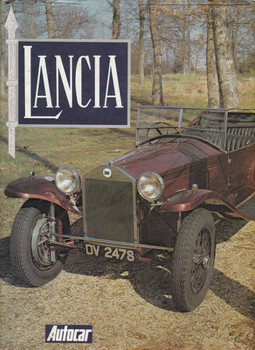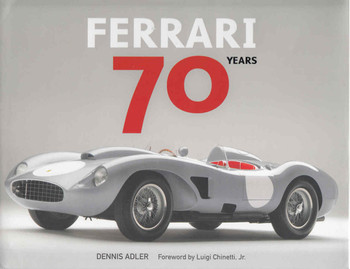Description
By: Bruce Lindsay .
For the first time you can view images of every Lancia passenger car and commercial vehicle, produced between 1908 and 1975, when new. Literature collections from around the world have contributed sales catalogues, factory and coachbuilders’ photos, and period illustrated advertisements which leave no doubt how each model was presented for sale by the factory.
The book will comprise
- ca. 400 pages printed in full colour on heavyweight silk art paper
- Foreword by international motoring journalist Ian Fraser
- more than 800 original illustrations of every Lancia production model, including commercial vehicles
- data panels for every model, offering detailed specifications, prices when new, production numbers and much more
- hard binding, colour dust-wrapper and strong slipcase
- DVD offering images of nearly 300 Lancia sales brochures from 1908 to 1975
Viva Lancia, September 2009
Reinventing the motoring book sounds like some geek’s whacky venture into electronic publishing. Yet LANCIA 70 Years of Trailblazing by Bruce Lindsay, a traditional landscape-format publication, has the content turned on its head. A conventional Lancia history it is not - at least not in the way of Wim Oude Weernink’s magnificent work, La Lancia. The difference is that this new book focuses on Lancia talking about itself.
Each section - there are four of them in chronological order which make up almost 400 pages in total - has its own concise yet most informative introduction, often with quotes from contemporary, independent commentators such as the motoring journals of the era.
They make compelling reading... And so do the specification pages, which follow a consistent style right through the book, making comparisons easy. When did you last spend 15 minutes studying the specifications and dimensions of the Type 56 Delta, Type 58 Epsilon and Type 60 Eta from 1911, 1912 and 1913 respectively? Even if you didn’t bother, it’s worth noting how Lancia have mined the past for the names of current and recent models.
Of course, that first 70 years of Lancia was not about cars alone. The commercial vehicles, including motor coaches as well as lorries, were revered for their excellence. Many were the occasions in the ’70s and ’80s when I struggled to overtake long-snouted, aged Lancia Esatau lorries, loaded to the gunwales and pulling draw-bar trailers across the mountains of central Italy.
And it is a matter of huge regret that the emotive interurbano coach, with its 8.8 litre diesel engine mounted horizontally behind the front axle line in a specially developed chassis frame designed for good stability and passenger convenience, seem to have vanished, brought down by economic change and technical development. Is there a preservation group in Italy that has saved at least some examples? Such beautiful architecture, as seen in the Padana coaches, deserves its place in history.
If they really have gone to the great smelter, at least their visual representation is preserved in Lindsay’s book. And so is a lot else besides. Almost every illustration and photograph reproduced is part of the promotional material contemporary with the vehicles concerned. This is Lancia’s take on Lancia through its own sales literature. And truly fascinating stuff. You don’t have to be a fantasist or a dreamer to conjure up an image of visiting a showroom, looking at the shining vehicles on the floor and then departing with brochures in hand for more leisurely contemplation of what your money would buy. Good idea, bad idea, no idea; it’s all encapsulated in these exceptionally high quality reproductions, something that’s difficult to achieve. They illuminate the passage of time.
Attached to this mighty tome (inside back cover) is a DVD of images of sales brochures, itself a serious work only made possible by relentless dedication at the scanner and keyboard. Hours of harmless fun for all. For we Lancia folk, the $150 price of the book becomes less and less significant in the face of such information.
Today’s motor industry sales promotion departments would not readily recognise Lancia’s approach, and would probably be very sniffy about the standard of illustration and photography. Would-be customers were once expected to know about motor cars, so that the printed facts spoke for themselves without adornment. No need for Lancia to indulge in boastful claims, as is today’s industry norm.
Some of the material originated in the United States where Lancia had a presence based initially on the Theta between 1913 and 1919 when a Square Edge Hydroplane bodied model would liberate $5750 from your bank account. There were innumerable other styles. All were costly cars but also rather grand. and technically well ahead of their US rivals. Lancia did not body the Trikappa (1922-1925) but provided buyers with delightfully simple profile illustrations of no fewer than eight approved styles from outside coachbuilders. Since I would have let the side down by wanting to drive myself, I would have ordered the conservative six-light saloon rather than something that put the chauffeur in the elements.
On this side of the Atlantic I would have been looking to trade-in my Trikappa a few years later, when Lambda production commenced in 1923; and again in 1927 for a short wheelbase Casaro-bodied sports car. Quite irresistible, then as now.
The copy in Curtis Automobile Company’s advertisement (they were the sole UK concessionaires) was effusive in praise of the Lambda in 1928 press advertisements, pointing out that the top speed of rivals was as nothing compared to the roadholding and handling of the Lambda which provided excellent average speed point to point; and, in seeking women buyers, said a girl could drive a Lambda 300 miles and be ready for the dance that evening. Perhaps a little patronising these days - and maybe not such a dignified advertisement even then.
I have spent hours contemplating whether I like the Pinin Farina bodies more than those of Castagna but decided in the end that the PF pillarless saloon coachwork would adorn my Dilambda or, as the Americans had designated it, the Lancia Eight. History would have been on my side, for pillarless construction was chosen for the volume produced Aprilia, Ardea and Aurelia saloons. The well-off were spoiled for choice if they ordered an Astura between 1931 and 1946. Some of the coachwork was wonderful but perhaps a little flashy in response to the politics of the times. Even so...
In the 1930s, Italian coachbuilders absolutely thrived. There were knock-out designs for the little Aprilias as well as for grander chassis. I would have been a Lancia salesman’s dream because I quickly lost my heart to the Pinin Farina cabriolet two-place Sport design, which had had some concorso di eleganza prizes to its name. I’m not at all surprised. And, damn it, I’m in love again, this time with another Pinin Farina design, a luscious Aprilia convertible although it does look a shade too long in the wheelbase when seen in profile. I can live with that, though.
Then ever onwards into the post-war period of reconstruction, when utilitarian vehicles evolved, in some instances, from the Ardea.
If Francesco De Virgilio had not worked so hard on the V6 engine during the war there would have been no Aurelia around which Lancia could form a backbone for the future. I’m admittedly biased but I would never have settled for just a single Aurelia. This book has reminded me that I would also have to have had a B20GT, a Viotti ‘woody’ for practical and self-justification reasons, and a B24 Spider - well, because I deserve it.
Author Bruce Lindsay is no stranger to Lancias. He has two lovely Flaminias: a Touring GT and a PF Coupe, and can occasionally be seen baying at the moon in the hope of attracting a B20GT or a Flavia convertible to his garage. The sale of his two previous Flavias in the not-too-distant past remains a subject of regret. The two Fulvias that entered my life years ago are still strongly missed, so I know how he feels.
Ian Fraser
Other Details
Additional Information
Condition Sync Code: |
1000 |
Author: |
Bruce Lindsay |
Book Title: |
Lancia - 70 Years Of Trailblazing |
Language: |
English |
Sync Category Code: |
261186 |


























